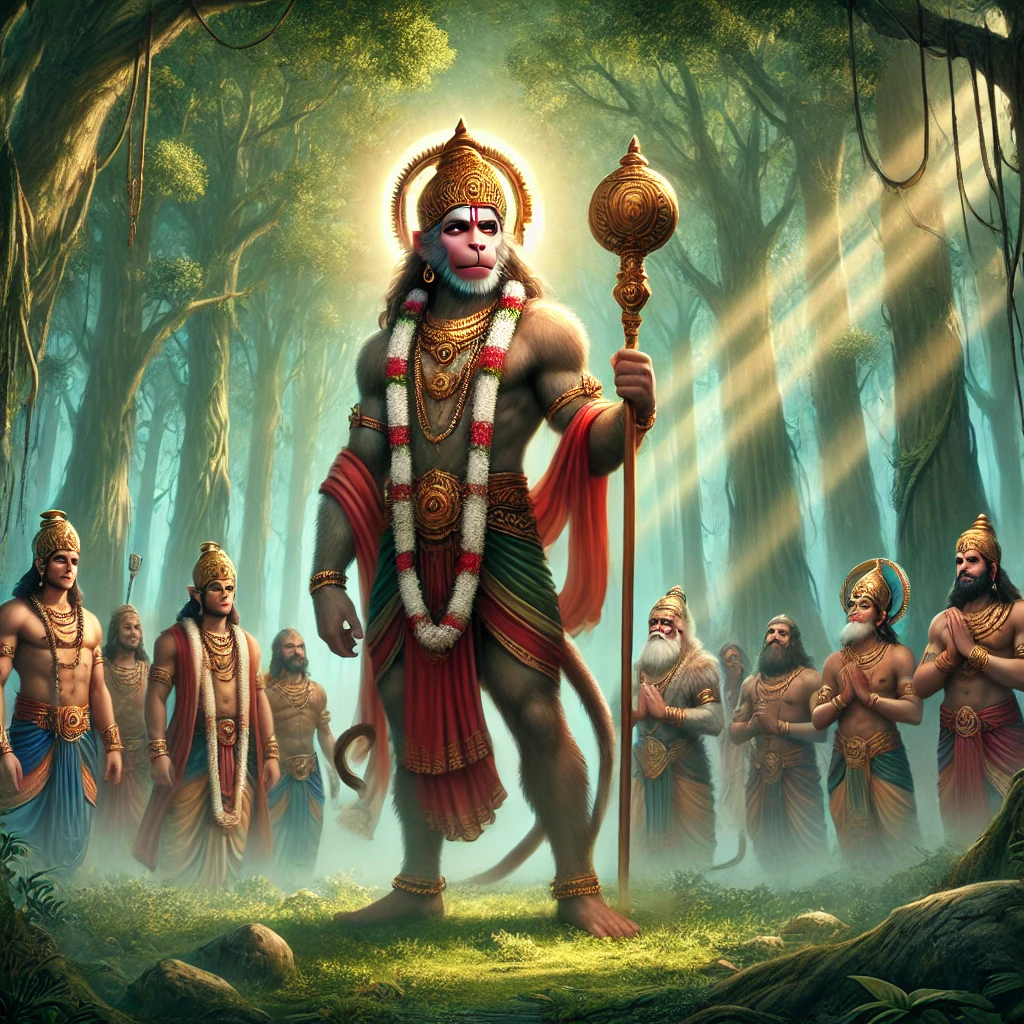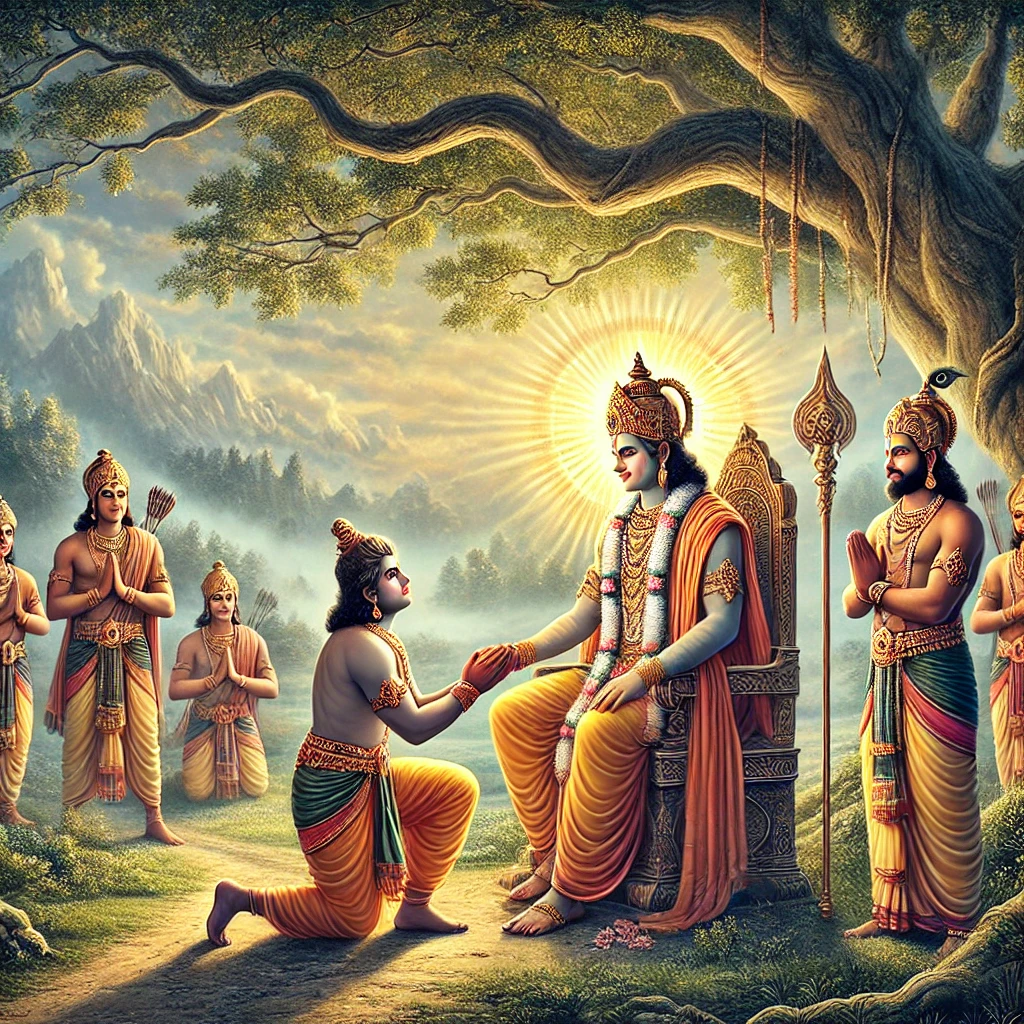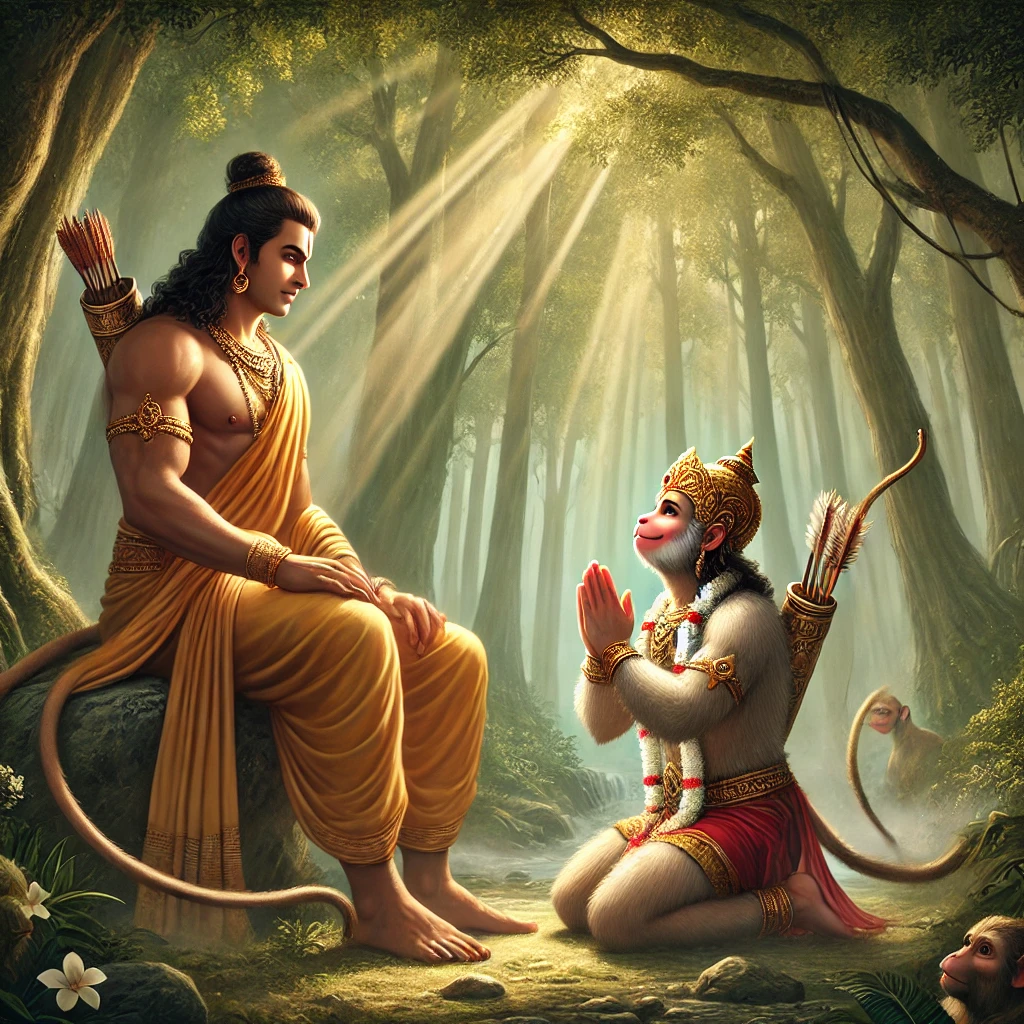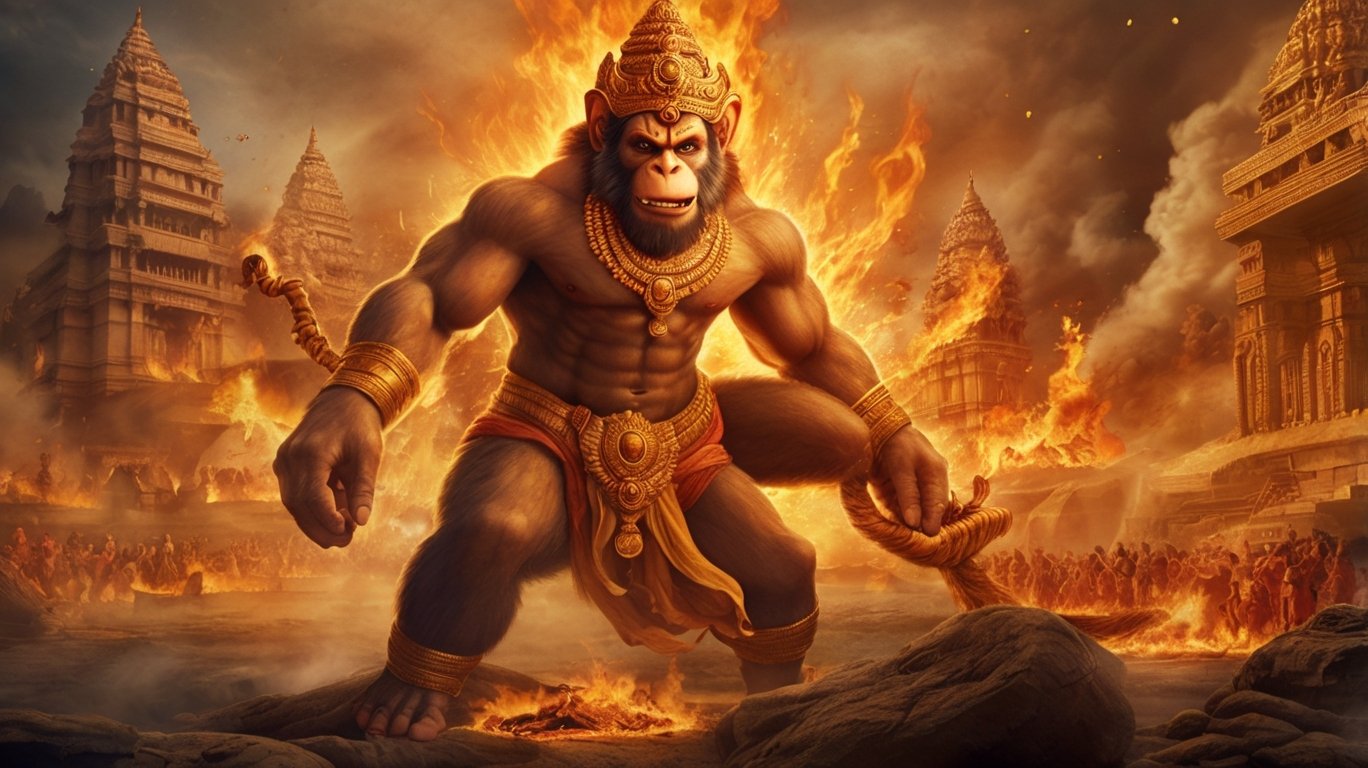Table of Contents
Introduction
Welcome to Bedesii.com! In this enlightening exploration of Sundarkand, we dive deep into verses that reveal the timeless themes of devotion, wisdom, and divine connection. Here, every word carries profound teachings that illustrate Lord Rama’s compassionate nature and the unwavering faith of his followers. These verses bring to life the journey of Vibhishana, Hanuman, and the monkey army as they traverse challenges in their mission to rescue Sita, guided by devotion and righteousness. Prepare to immerse yourself in the beauty of this divine narrative, where each verse inspires us to embrace resilience, compassion, and unity in our own spiritual journeys.

Doha
jinha payanha ke padukanhi bharatu rahe mana lai,
te pada aju bilokihau inha nayananhi aba jai.
Explanation
“jinha payanha ke padukanhi bharatu rahe mana lai” expresses the deep yearning of devotees who cherish the divine feet of Lord Rama, symbolizing unwavering faith and surrender to the divine will. The subsequent line, “te pada aju bilokihau inha nayananhi aba jai,” conveys the desire to behold Lord Rama’s form, emphasizing the profound emotional connection between the devotee and the deity. Together, these lines illustrate that true devotion involves surrendering to the divine and yearning to experience the presence of the beloved deity, reflecting the deep love and faith inherent in spiritual practice.
Chaupai
ehi bidhi karata saprema bichara, ayau sapadi sindhu ehi para.
kapinha bibhishanu avata dekha, janakou ripu duta bisesha.tahi rakhi kapisa pahir ae, samachara saba tahi sunae.
kaha sugriva sunahu raghurai, ava milana dasanana bhai.kaha prabhu sakha bujhiai kaha, kahai kapisa sunahu naranaha.
jani na jai nisachara maya, kamarupa kehi karana aya.bheda hamara lena satha ava, rakhia badhi mohi asa bhava.
sakha niti tumha niki bichari, mama pana saranagata bhayahari.suni prabhu bachana harasha hanumana, saranagata bacchala bhagavana.
Explanation
In these verses from the Sundarkand, the characters engage in a heartfelt discussion filled with devotion, strategy, and unity in their quest to rescue Sita. The lines begin by emphasizing the deep affection and camaraderie among them as they deliberate their plans, likening their efforts to crossing a vast ocean, symbolizing the significant challenges they face. The arrival of Vibhishana is noted, as he is a crucial figure representing loyalty to righteousness. His presence signifies a shift in allegiance from Ravana to Lord Rama, emphasizing the importance of adhering to Dharma.
Vibhishana’s duty to communicate essential information to the monkeys (kapisha) highlights the necessity of collaboration in their mission. He is tasked with conveying news about Sita and the strategic plans against Ravana, reflecting the importance of unity in their efforts. The dialogue continues with references to Sugriva and Rama, who are eager to hear from Vibhishana about the situation and their next steps. Vibhishana reassures them that he is committed to the cause and confident in their ability to succeed.
As the conversation unfolds, Vibhishana expresses his understanding of the threat posed by the demons (nisachara) and the deceptive nature of their leader, Ravana. He emphasizes that they must stay vigilant and strategic in their approach, reflecting his wisdom and experience. Vibhishana’s insistence on unity and careful planning underscores the significance of cooperation and the shared goal of rescuing Sita.
Doha
saranagata kahu je tajahi nija anahita anumani,
te nara pavara papamaya tinhahi bilokata hani
Explanation
This doha imparts a profound spiritual lesson regarding the importance of responsibility and the consequences of one’s actions. It emphasizes that those who seek refuge in the divine must not abandon their duties. The term “saranagata” refers to individuals who take shelter in the divine, implying that genuine devotion requires both surrender and a commitment to one’s responsibilities. The first part of the doha suggests that those who neglect their obligations will ultimately face dire consequences, as abandoning one’s duties can lead to moral failure and spiritual downfall.
The second line points out that those who live their lives filled with sinful actions (“papamaya”) and disregard their responsibilities will encounter ruin (“bilokata hani”). This serves as a cautionary reminder that irresponsibility can have detrimental effects not only on the individual but also on the broader community.
Chaupai
koti bipra badha lagahi jahu, ae sarana tajau nahi tahu.
sanamukha hoi jiva mohi jabahi, janma koti agha nasahi tabahi.papavanta kara sahaja subhau, bhajanu mora tehi bhava na kau.
jou pai dushtahridaya soi hoi, more sanamukha ava ki soi.nirmala mana jana so mohi pava, mohi kapata chala chidra na bhava.
bheda lena pathava dasasisa, tabahu na kachu bhaya hani kapisa.jaga mahu sakha nisachara jete, lachimanu hanai nimisha mahu tete.
jau sabhita ava saranai, rakhihau tahi prana ki nai.
Explanation
In these verses from the Sundarkand, we encounter a rich exploration of the themes of devotion, divine protection, and the significance of righteousness in the face of adversity.
The verses begin with “koti bipra badha lagahi jahu, ae sarana tajau nahi tahu,” highlighting the unwavering belief that even if millions of Brahmins (bipra) were to gather in prayer, one should not abandon the refuge of the divine. This illustrates the idea that true safety lies in surrendering to God, regardless of external circumstances.
The subsequent line, “sanamukha hoi jiva mohi jabahi, janma koti agha nasahi tabahi,” emphasizes that when one faces the divine with sincerity, their countless sins (janma koti agha) can be washed away. It underscores the transformative power of genuine devotion, suggesting that true devotion can lead to spiritual liberation.
“papavanta kara sahaja subhau, bhajanu mora tehi bhava na kau,” conveys that even those with sinful tendencies (papavanta) can attain purity through devotion, indicating that one’s nature does not prevent them from seeking divine grace. The speaker expresses that devotion to God transcends all past misdeeds.
The line “jou pai dushtahridaya soi hoi, more sanamukha ava ki soi,” suggests that regardless of the wickedness of others (“dushtahridaya”), the divine presence is unshakeable. It highlights that no matter how sinful one may be, the opportunity for redemption through divine grace remains.
“nirmala mana jana so mohi pava, mohi kapata chala chidra na bhava,” indicates that those with pure hearts (nirmala mana) can attain God, emphasizing that sincerity in devotion will lead to a genuine connection with the divine.
Finally, the concluding lines, “bheda lena pathava dasasisa, tabahu na kachu bhaya hani kapisa,” reaffirm that even when faced with challenges or obstacles, such as those posed by Ravana (dasasisa), the faithful need not fear, as long as they remain devoted and seek refuge in the divine. The mention of “jaga mahu sakha nisachara jete, lachimanu hanai nimisha mahu tete” signifies that even in the presence of evil forces (nisachara), divine protection is ever near.
Doha
ubhaya bhati tehi anahu hasi kaha kripaniketa,
jaya kripala kahi kapi chale angada hanu sameta
Explanation
This doha celebrates the joy and grace that comes from divine blessings and the camaraderie among the devoted.
The opening line, “ubhaya bhati tehi anahu hasi kaha kripaniketa,” conveys that both groups (ubhaya bhati)—likely referring to Lord Rama and his devoted followers—are filled with joy and laughter. The phrase “kripaniketa” signifies the manifestation of divine grace and compassion, suggesting that the presence of the divine brings happiness and camaraderie among the devotees.
The second line, “jaya kripala kahi kapi chale angada hanu sameta,” indicates that with the blessings of the divine, the monkeys (kapi), including Angada and Hanuman, set forth on their mission. The term “kripala” refers to the gracious one (Lord Rama), and the phrase suggests that the power of devotion and divine support empowers them in their endeavors.
Chaupai
sadara tehi age kari banara, chale jaha raghupati karunakara.
durihi te dekhe dvau bhrata, nayanananda dana ke data.bahuri Rama chabidhama biloki, raheu thatuki ekataka pala roki.
bhuja pralamba kanjaruna lochana, syamala gata pranata bhaya mochana.singha kandha ayata ura soha, anana amita madana mana moha.
nayana nira pulakita ati gata, mana dhari dhira kahi mridu bata.natha dasanana kara mai bhrata, nisichara bansa janama suratrata.
sahaja papapriya tamasa deha, jatha ulukahi tama para neha.
Explanation
These verses from the Sundarkand depict the deep bond of devotion and the emotional landscape of Lord Rama and his companions as they journey through the forest. The opening lines illustrate how the group, led by the compassionate Lord Rama, advances with purpose, evoking joy in the brothers Lakshmana and Shatrughna upon reuniting with him. Rama’s captivating presence is described with imagery of his strength and grace, highlighting his long arms and enchanting eyes. The emotional intensity is palpable, with tears of joy in their eyes as they express their feelings of love and devotion. The verses also reflect the challenges posed by the demon clan, portraying the struggle between light and darkness. Overall, they emphasize the unity, strength, and divine guidance that empower the characters in their mission.
Doha
sravana sujasu suni ayau prabhu bhanjana bhava bhira,
trahi trahi arati harana sarana sukhada raghubira
Explanation
The line “sravana sujasu suni ayau prabhu bhanjana bhava bhira,” signifies that upon hearing the glorious name of Lord Rama (sravana sujasu), the speaker feels a profound sense of reverence and devotion. The phrase “bhanjana bhava bhira” refers to the Lord as the destroyer of all fears and negative emotions, emphasizing his protective nature.
The subsequent line, “trahi trahi arati harana sarana sukhada raghubira,” is a plea for help (trahi trahi) to Lord Rama, who is known for removing hardships and granting refuge (sarana). The term “arati harana” means that he dispels darkness and negativity, while “sukhada” signifies that he bestows happiness and peace upon his devotees. The mention of “Raghubira” reinforces Rama’s lineage (Raghu), emphasizing his noble and divine qualities.
Chaupai
asa kahi karata dandavata dekha, turata uthe prabhu harasha bisesha.
dina bachana suni prabhu mana bhava, bhuja bisala gahi hridaya lagava.anuja sahita mili dhiga baithari, bole bachana bhagata bhayahari.
kahu lankesa sahita parivara, kusala kuthahara basa tumhara.khala mandali basahu dinu rati, sakha dharama nibahai kehi bhati.
mai janau tumhari saba riti, ati naya nipuna na bhava aniti.baru bhala basa naraka kara tata, dushta sanga jani dei bidhata.
aba pada dekhi kusala raghuraya, jau tumha kinhi jani jana daya.
Explanation
In these verses from the Sundarkand, the imagery of devotion and reverence is prominently displayed as a devotee bows in humility before Lord Rama. This act of dandavata (prostration) evokes a special joy in Rama, who immediately rises to embrace his devotee, signifying the deep connection between the divine and his followers. The emotional bond is further emphasized as Lord Rama listens attentively to the words of his devotee, embracing him warmly, which symbolizes safety and acceptance in his divine presence. The gathering of Rama with his companions, including Lakshmana, fosters an atmosphere of camaraderie and trust, where heartfelt expressions flow freely, revealing the genuine love and devotion they hold for their Lord.
The verses also reflect Lord Rama’s compassionate nature, as he expresses concern for Ravana and his family, wishing for their well-being and an end to their harmful behaviors. This aspect of Rama’s character showcases his righteousness and the emphasis on dharma (righteousness) over mere vengeance. The desire for evil company to depart and for righteousness to prevail highlights the overarching theme of moral integrity. The speaker’s acknowledgment of their understanding of Rama’s ways underlines the importance of maintaining virtuous conduct, while the final lines convey a message of hope, suggesting that even those in the depths of darkness can find redemption through divine guidance. Together, these verses encapsulate the transformative power of devotion, compassion, and the quest for righteousness in the face of adversity.
Doha
taba lagi kusala na jiva kahu sapanehu mana bisrama,
jaba lagi bhajata na Rama kahu soka dhama taji kama.
Explanation
This doha expresses a profound sentiment regarding the importance of devotion to Lord Rama and the transformative power it holds in alleviating suffering. The line “taba lagi kusala na jiva kahu sapanehu mana bisrama” conveys that as long as one remains devoted to Lord Rama (bhajata na Rama), they cannot experience true happiness or peace (kusala) in their life. The phrase “sapaehu mana bisrama” suggests that until one truly embraces devotion, the mind remains restless and unable to find solace.
The subsequent line, “jaba lagi bhajata na Rama kahu soka dhama taji kama,” emphasizes that without worshipping Lord Rama, individuals will continue to dwell in the realm of sorrow (soka dhama) and suffer from worldly attachments (kama). This highlights the idea that true liberation from grief and the burdens of life comes from surrendering to the divine and maintaining a connection with Rama through heartfelt devotion. Ultimately, the doha encapsulates the essence of spiritual practice, illustrating that devotion to Lord Rama is the key to finding inner peace and overcoming the trials of existence.
Chaupai
taba lagi hridaya basata khala nana, lobha moha macchara mada mana.
jaba lagi ura na basata raghunatha, dhare chapa sayaka kati bhatha.mamata taruna tami adhiari, raga dvesha uluka sukhakari.
taba lagi basati jiva mana mahi, jaba lagi prabhu pratapa rabi nahi.aba mai kusala mite bhaya bhare, dekhi Rama pada kamala tumhare.
tumha kripala ja para anukula, tahi na byapa tribidha bhava sula.mai nisichara ati adhama subhau, subha acharanu kinha nahi kau.
jasu rupa muni dhyana na ava, tehi prabhu harashi hridaya mohi lava.
Explanation
In these verses from the Sundarkand, the inner struggles and transformation of a devotee are illustrated, underscoring how devotion to Lord Rama purifies the heart and banishes inner darkness. The opening lines describe how the heart is occupied by negative qualities such as greed, attachment, envy, and pride as long as Lord Rama, symbolized by his bow and arrows (signifying divine power and righteousness), does not reside in one’s heart. This imagery of inner negativity highlights how human weaknesses and worldly attachments cloud the mind when one lacks devotion.
The following lines further this idea by comparing ignorance and attachment to darkness (tamasa) and describing emotions like attachment and aversion as comforting to one who is metaphorically like an owl, at ease in the darkness of material desires. Yet, when Lord Rama’s divine presence (like the sun) enters, these negative tendencies vanish. The devotee then expresses how seeing Rama’s lotus feet has brought them peace, liberating them from fear and worldly suffering. They recognize that those who receive Rama’s grace remain unaffected by the threefold suffering (adhyatmika, adhibhautika, and adhidaivika). Concluding with humility, the devotee admits their sinful nature and expresses amazement that a being as lowly as themselves could be embraced by the Lord. This moment underscores the boundless compassion of Lord Rama, who accepts even those considered unworthy, offering them refuge and salvation.
Doha
ahobhagya mama amita ati Rama kripa sukha punja,
dekheu nayana biranchi Shiva sebya jugala pada kanja.
Explanation
In this doha, the devotee expresses profound gratitude and amazement at the extraordinary fortune they feel in receiving Lord Rama’s grace. The opening words, “ahobhagya mama amita ati” (my boundless good fortune), emphasize how deeply they value this moment of divine favor. The devotee acknowledges Lord Rama’s “kripa sukha punja” (the source of blissful mercy) as an immense blessing that fills their life with joy and peace.
The doha highlights the sacredness of witnessing Rama’s lotus feet, which are revered by even the highest of deities, Brahma and Shiva. This reference underscores the supreme nature of Lord Rama and the significance of his divine presence. By mentioning Brahma and Shiva, who themselves are embodiments of knowledge and destruction, the doha illustrates that experiencing Rama’s grace is an honor beyond any earthly or divine achievement. This moment of darshan (divine sight) thus becomes a pinnacle of spiritual fulfillment for the devotee, symbolizing liberation and eternal peace.
Chaupai
sunahu sakha nija kahau subhau, jana bhusundi sanbhu girijau.
jau nara hoi charachara drohi, avai sabhaya sarana taki mohi.taji mada moha kapata chhala nana, karau sadya tehi sadhu samana.
janani janaka bandhu suta dara, tanu dhanu bhavana suhrida parivara.saba kai mamata taga batori, mama pada manahi ba dha bari dori.
samadarasi iccha kachu nahi, harasha soka bhaya nahi mana mahi.
Explanation
In these verses, Lord Rama explains his compassionate nature to his devotee, describing the transformative power of sincere devotion. He reveals that even if a person has committed wrongs against the entire world (“charachara drohi”), if they come to him seeking refuge with humility, setting aside their pride, attachment, deceit, and falsehood, he accepts them as a pure-hearted devotee. This unconditional acceptance demonstrates Rama’s boundless compassion and his willingness to forgive and elevate anyone who approaches him with a sincere heart.
Further, Rama describes the ideal devotee as one who renounces attachment to worldly relationships and possessions—such as family, wealth, and material comforts—and gathers all affections into a single, unbreakable thread of devotion tied to his lotus feet. This devotee attains a state of equanimity, free from desires, unaffected by joy and sorrow, and without fear. These verses encapsulate the essence of true devotion, where unwavering focus on the divine replaces all worldly attachments, leading the devotee to a life of inner peace, balance, and liberation.
FAQ
What does Rama promise Vibhishana?
Rama promises Vibhishana that he will be protected and honored for his loyalty and righteousness. By choosing to ally with Rama, Vibhishana is assured of his place as a devoted follower and is promised divine grace for his actions in abandoning Ravana.
What did Vibhishana tell Ram?
Vibhishana informed Rama about Ravana’s plans, including the location of Sita and the strengths and weaknesses of Ravana’s forces. His insights were crucial for strategizing their approach to rescue Sita and defeat Ravana
Could Ram win without Vibhishana?
While Rama is powerful, Vibhishana’s knowledge and loyalty were instrumental in securing victory against Ravana. His defection provided vital intelligence that contributed significantly to Rama’s strategy, suggesting that while Rama could potentially win, Vibhishana’s support was invaluable.
Is Vibhishana dead or alive?
Vibhishana is alive at the end of the Ramayana. After the defeat of Ravana, he becomes the king of Lanka and continues to serve Rama faithfully, embodying righteousness and devotion.
Who killed Vibhishana?
Vibhishana was not killed; he remained a loyal ally to Rama throughout the epic. His commitment to righteousness ensured his survival and prominence in the narrative.
Was Vibhishana brother of Ram?
No, Vibhishana was not a brother of Rama. He was the younger brother of Ravana, the demon king of Lanka, who chose to side with Rama due to his adherence to Dharma.
Where is Vibhishana now?
Vibhishana, after Ravana’s defeat, is believed to have ruled Lanka for many years with wisdom and righteousness, as promised by Lord Rama. According to some spiritual beliefs, Vibhishana continues to live in the form of a divine presence, guiding Lanka and following the path of dharma (righteousness). In Kalyug (the present age), there is no specific mention of his physical presence, but some believe that he may still be spiritually active.
Proof that Vibhishana is still alive
There is no historical or physical proof to confirm that Vibhishana is still alive in the physical sense. However, in Hindu tradition, many divine figures are believed to transcend time and live on in spirit, guiding and protecting dharma. As such, Vibhishana’s presence is seen in the continuity of his legacy, which aligns with the divine order.
Vibhishana’s real photo
As Vibhishana was a figure from ancient mythology, there are no real photos or images of him. Artistic representations of Vibhishana vary, but they are symbolic depictions.based on stories from the Ramayana.
Vibhishana and Mandodari’s son
Vibhishana and Mandodari did not have any children together in most versions of the Ramayana. Mandodari, Ravana’s wife, had children with Ravana, including the well-known son Indrajit (Meghanada), who fought in the battle against Rama’s army.
Who killed Vibhishana?
Vibhishana was not killed. After the death of Ravana, he was crowned as the king of Lanka by Lord Rama, as he had remained loyal to righteousness. Vibhishana is said to have ruled Lanka justly and lived after the events of the Ramayana.
Vibhishana’s wife
Vibhishana’s wife is named Sarama (or some sources mention other names depending on the tradition). She is mentioned as a virtuous and supportive spouse who stood by her husband’s decision to leave Ravana and join Rama’s side.
Vibhishana’s children
There are no specific mentions of Vibhishana’s children in the main texts of the Ramayana. Some lesser-known texts or folklore might suggest that he had descendants who continued to rule in Lanka, but this is not a central aspect of the Ramayana.
Where is Vibhishana now in Kalyug?
In Kalyug, it is believed by some spiritual traditions that Vibhishana’s divine presence still remains, but his physical form is not found. According to certain interpretations, Vibhishana may still reside in spiritual realms, continuing his role as a protector of dharma, guiding the righteous path. There are no definitive texts confirming his physical presence on Earth in the present age.







